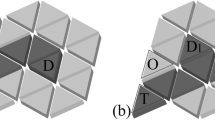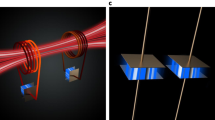Abstract
Stationary wireless power transfer has been deployed commercially and can be used to charge a variety of devices, including mobile phones and parked electric vehicles. However, wireless power transfer set-ups typically suffer from an inherent sensitivity to the relative movement of the device with respect to the power source. Nonlinear parity–time symmetric circuits could be used to deliver robust wireless power transfer even while a device is moving rapidly, but previous implementations have relied on an inefficient gain element based on an operation-amplifier circuit, which has inherent loss, and hence have exhibited poor total system efficiency. Here we show that robust and efficient wireless power transfer can be achieved by using a power-efficient switch-mode amplifier with current-sensing feedback in a parity–time symmetric circuit. In this circuit, the parity–time symmetry guarantees that the effective load impedance on the switch-mode amplifier remains constant, and hence the amplifier maintains high efficiency despite variation of the transfer distance. We experimentally demonstrate a nonlinear parity–time symmetric radiofrequency circuit that can wirelessly transfer around 10 W of power to a moving device with a nearly constant total efficiency of 92% and over a distance from 0 to 65 cm.
This is a preview of subscription content, access via your institution
Access options
Access Nature and 54 other Nature Portfolio journals
Get Nature+, our best-value online-access subscription
$29.99 / 30 days
cancel any time
Subscribe to this journal
Receive 12 digital issues and online access to articles
$119.00 per year
only $9.92 per issue
Buy this article
- Purchase on Springer Link
- Instant access to full article PDF
Prices may be subject to local taxes which are calculated during checkout




Similar content being viewed by others
Data availability
The datasets generated and analysed during the current study are available at https://doi.org/10.6084/m9.figshare.11936229.v1.
References
Kurs, A. et al. Wireless power transfer via strongly coupled magnetic resonances. Science 317, 83–86 (2007).
Karalis, A., Joannopoulos, J. D. & Soljačić, M. Efficient wireless non-radiative mid-range energy transfer. Ann. Phys. 323, 34–48 (2008).
Assawaworrarit, S., Yu, X. & Fan, S. Robust wireless power transfer using a nonlinear parity–time-symmetric circuit. Nature 546, 387–390 (2017).
Chabalko, M. J., Shahmohammadi, M. & Sample, A. P. Quasistatic cavity resonance for ubiquitous wireless power transfer. PLoS ONE 12, e0169045 (2017).
Ra’Di, Y. et al. On-site wireless power generation. IEEE Trans. Antennas Propag. 66, 4260–4268 (2018).
Hou, Y., Lin, M., Chen, W. & Yang, X. Parity–time-symmetric wireless power transfer system using switch-mode nonlinear gain element. In 2018 IEEE International Power Electronics and Application Conference and Exposition (PEAC) 1–5 (IEEE, 2018); https://doi.org/10.1109/PEAC.2018.8590364
Zhou, J., Zhang, B., Xiao, W., Qiu, D. & Chen, Y. Nonlinear parity–time-symmetric model for constant efficiency wireless power transfer: application to a drone-in-flight wireless charging platform. IEEE Trans. Ind. Electron. 66, 4097–4107 (2019).
Donaldson, P. E. K. Power for neurological prostheses: a simple inductive RF link with improved performance. J. Biomed. Eng. 9, 194–197 (1987).
Donaldson, P. E. K. Three separation-insensitive radiofrequency inductive links. J. Med. Eng. Technol. 11, 23–29 (1987).
Zierhofer, C. M. & Hochmair, E. S. High-efficiency coupling-insensitive transcutaneous power and data transmission via an inductive link. IEEE Trans. Biomed. Eng. 37, 716–722 (1990).
Kurs, A., Moffatt, R. & Soljačić, M. Simultaneous mid-range power transfer to multiple devices. Appl. Phys. Lett. 96, 044102 (2010).
Sample, A. P., Meyer, D. A. & Smith, J. R. Analysis, experimental results and range adaptation of magnetically coupled resonators for wireless power transfer. IEEE Trans. Ind. Electron. 58, 544–554 (2011).
Yu, X., Sandhu, S., Beiker, S., Sassoon, R. & Fan, S. Wireless energy transfer with the presence of metallic planes. Appl. Phys. Lett. 99, 214102 (2011).
Yu, X. et al. Wireless power transfer in the presence of metallic plates: experimental results. AIP Adv. 3, 062102 (2013).
Ho, J. S. et al. Wireless power transfer to deep-tissue microimplants. Proc. Natl Acad. Sci. USA 111, 7974–7979 (2014).
Hui, S. Y. R., Zhong, W. & Lee, C. K. A critical review of recent progress in mid-range wireless power transfer. IEEE Trans. Power Electron. 29, 4500–4511 (2014).
Li, S. & Mi, C. C. Wireless power transfer for electric vehicle applications. IEEE J. Emerg. Sel. Top. Power Electron. 3, 4–17 (2015).
Wang, G., Liu, W., Sivaprakasam, M. & Kendir, G. A. Design and analysis of an adaptive transcutaneous power telemetry for biomedical implants. IEEE Trans. Circuits Syst. I 2, 2109–2117 (2005).
Brecher, A. & Arthur, D. Review and Evaluation of Wireless Power Transfer (WPT) for Electric Transit Applications Report No. 0060 (FTA, 2014).
Rüter, C. E. et al. Observation of parity–time symmetry in optics. Nat. Phys. 6, 192–195 (2010).
El-Ganainy, R. et al. Non-Hermitian physics and PT symmetry. Nat. Phys. 14, 11–19 (2018).
Feng, L., Wong, Z. J., Ma, R.-M., Wang, Y. & Zhang, X. Single-mode laser by parity-time symmetry breaking. Science 346, 972–975 (2014).
Guo, A. et al. Observation of PT-symmetry breaking in complex optical potentials. Phys. Rev. Lett. 103, 093902 (2009).
Lin, Z. et al. Unidirectional invisibility induced by PT-symmetric periodic structures. Phys. Rev. Lett. 106, 213901 (2011).
Doppler, J. et al. Dynamically encircling an exceptional point for asymmetric mode switching. Nature 537, 76–79 (2016).
Chen, P.-Y. et al. Generalized parity–time symmetry condition for enhanced sensor telemetry. Nat. Electron. 1, 297–304 (2018).
Chen, W., Kaya Özdemir, Ş., Zhao, G., Wiersig, J. & Yang, L. Exceptional points enhance sensing in an optical microcavity. Nature 548, 192–196 (2017).
Hodaei, H. et al. Enhanced sensitivity at higher-order exceptional points. Nature 548, 187–191 (2017).
Sample, A. P., Waters, B. H., Wisdom, S. T. & Smith, J. R. Enabling seamless wireless power delivery in dynamic environments. Proc. IEEE 101, 1343–1358 (2013).
Kim, N. Y., Kim, K. Y., Choi, J. & Kim, C.-W. Adaptive frequency with power-level tracking system for efficient magnetic resonance wireless power transfer. Electron. Lett. 48, 452–454 (2012).
Beh, T. C., Kato, M., Imura, T., Oh, S. & Hori, Y. Automated impedance matching system for robust wireless power transfer via magnetic resonance coupling. IEEE Trans. Ind. Electron. 60, 3689–3698 (2013).
Larky, A. Negative-impedance converters. IRE Trans. Circuit Theory 4, 124–131 (1957).
Schindler, J., Li, A., Zheng, M. C., Ellis, F. M. & Kottos, T. Experimental study of active LRC circuits with PT symmetries. Phys. Rev. A 84, 040101 (2011).
Schindler, J. et al. PT-symmetric electronics. J. Phys. A 45, 444029 (2012).
Lin, Z., Schindler, J., Ellis, F. M. & Kottos, T. Experimental observation of the dual behavior of PT-symmetric scattering. Phys. Rev. A 85, 050101 (2012).
Kazimierczuk, M. K. RF Power Amplifiers (Wiley, 2008).
Sedra, A. S. & Smith, K. C. Microelectronic Circuits (Oxford Univ. Press, 2010).
Raab, F. Idealized operation of the class E tuned power amplifier. IEEE Trans. Circuits Syst. 24, 725–735 (1977).
Raab, F. H. et al. Power amplifiers and transmitters for RF and microwave. IEEE Trans. Microw. Theory Tech. 50, 814–826 (2002).
Li, H. et al. Design of a 10 kW GaN-based high power density three-phase inverter. In 2016 IEEE Energy Conversion Congress and Exposition (ECCE) 1–8 (IEEE, 2016); https://doi.org/10.1109/ECCE.2016.7855019
Choi, J., Tsukiyama, D., Tsuruda, Y. & Davila, J. M. R. High-frequency, high-power resonant inverter with eGaN FET for wireless power transfer. IEEE Trans. Power Electron. 33, 1890–1896 (2018).
Haus, H. A. Waves and Fields in Optoelectronics (Prentice Hall, 1984).
Acknowledgements
This work was supported by a Vannevar Bush Faculty Fellowship (grant no. N00014-17-1-3030) from the US Department of Defense.
Author information
Authors and Affiliations
Contributions
S.A. performed the simulations and measurements. S.F. supervised the project. Both authors contributed to writing the manuscript.
Corresponding author
Ethics declarations
Competing interests
The authors declare no competing interests.
Additional information
Publisher’s note Springer Nature remains neutral with regard to jurisdictional claims in published maps and institutional affiliations.
Supplementary information
Supplementary Information
Supplementary Figs. 1–4 and discussion.
Source data
Source Data Fig. 1
Simulated total system efficiencies.
Source Data Fig. 2
Ideal amplifier waveforms.
Source Data Fig. 3
Calculated switching efficiency (Fig. 3a) and oscillation frequency and effective load impedance (Fig. 3b).
Source Data Fig. 4
Measured oscillation frequency, delivered power, total efficiency and the amplifier’s waveforms.
Rights and permissions
About this article
Cite this article
Assawaworrarit, S., Fan, S. Robust and efficient wireless power transfer using a switch-mode implementation of a nonlinear parity–time symmetric circuit. Nat Electron 3, 273–279 (2020). https://doi.org/10.1038/s41928-020-0399-7
Received:
Accepted:
Published:
Issue Date:
DOI: https://doi.org/10.1038/s41928-020-0399-7
This article is cited by
-
Wireless power and information dual transfer system via magnetically coupled resonators
Communications Engineering (2024)
-
Intelligent wireless power transfer via a 2-bit compact reconfigurable transmissive-metasurface-based router
Nature Communications (2024)
-
Wireless dielectrophoresis trapping and remote impedance sensing via resonant wireless power transfer
Nature Communications (2023)
-
Investigation of temperature variations on a Class-E inverter and proposing a compensation circuit to prevent harmful effects on biomedical implants
Scientific Reports (2023)
-
Wirelessly powered motor operation in dynamic scenarios using non-Hermitian parity-time symmetry
Scientific Reports (2023)



